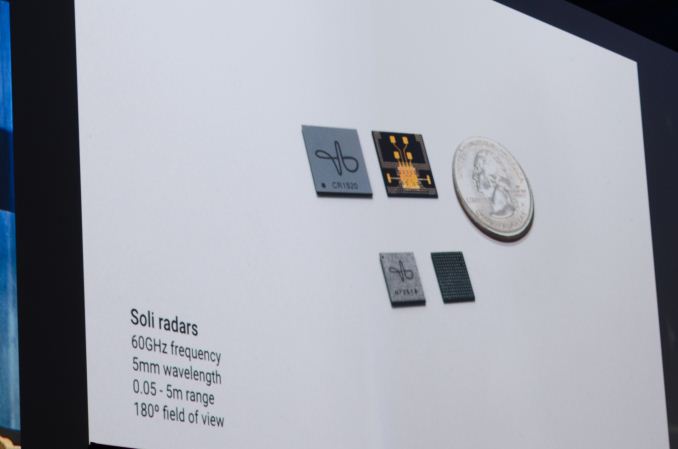60GHz (5mm wavelength), 0.05 to 5m range, 180 degree field of view.
Welcome to Project Soli by OneTech2
Project Soli is developing a new interaction sensor using radar technology. The sensor can track sub-millimeter motions at high speed and accuracy. It fits onto a chip, can be produced at scale and built into small devices and everyday objects.
Related/Background:
- Google unveils Project Soli, a radar-based wearable to control anything
- Google's 'Project Soli' Radar Hand Tracking and How VR and AR Might Use it - Road to VR
- Multi-sensor System for Driver’s Hand-Gesture Recognition FG2015.pdf
- Short-Range FMCW Monopulse Radar for Hand-Gesture Sensing
- Understanding Project Soli and Jacquard: Wearable Control Breakthroughs
- Molchanov, P.; Gupta, S.; Kim, K.; Pulli, K., "Short-range FMCW monopulse radar for hand-gesture sensing," in Radar Conference (RadarCon), 2015 IEEE , vol., no., pp.1491-1496, 10-15 May 2015
- doi: 10.1109/RADAR.2015.7131232
- Abstract: Intelligent driver assistance systems have become important in the automotive industry. One key element of such systems is a smart user interface that tracks and recognizes drivers' hand gestures. Hand gesture sensing using traditional computer vision techniques is challenging because of wide variations in lighting conditions, e.g. inside a car. A short-range radar device can provide additional information, including the location and instantaneous radial velocity of moving objects. We describe a novel end-to-end (hardware, interface, and software) short-range FMCW radar-based system designed to effectively sense dynamic hand gestures. We provide an effective method for selecting the parameters of the FMCW waveform and for jointly calibrating the radar system with a depth sensor. Finally, we demonstrate that our system guarantees reliable and robust performance.
- keywords: {CW radar;FM radar;computer vision;driver information systems;gesture recognition;radar imaging;automotive industry;computer vision technique;depth sensor;hand-gesture sensing;intelligent driver assistance system;short-range FMCW monopulse radar;smart user interface;Doppler radar;Frequency modulation;Radar measurements;Radar tracking;Receivers;Sensors},
- URL: http://ieeexplore.ieee.org/stamp/stamp.jsp?tp=&arnumber=7131232&isnumber=7130933
- Bo Tan; Woodbridge, K.; Chetty, K., "A real-time high resolution passive WiFi Doppler-radar and its applications," in Radar Conference (Radar), 2014 International , vol., no., pp.1-6, 13-17 Oct. 2014
- doi: 10.1109/RADAR.2014.7060359
- Abstract: The design and implementation of a real-time passive high Doppler resolution radar system is described in this paper. Batch processing and pipelined processing flow are introduced for reducing the processing time to enable real-time display. The proposed method is implemented on a software defined radio (SDR) platform. Two experiments using this system are described: one based on small human body motions and another one on hand gesture detection. The results from these experiments show that the proposed system can be used in a range of application scenarios such as eHealth, human-machine interaction and high accuracy indoor target tracking.
- keywords: {Doppler radar;passive radar;software radio;wireless LAN;SDR platform;batch processing;eHealth;hand gesture detection;human-machine interaction;indoor target tracking;pipelined processing flow;real-time high resolution passive WiFi doppler-radar;real-time passive high Doppler resolution radar system;software defined radio;Doppler radar;Doppler shift;IEEE 802.11 Standards;Passive radar;Real-time systems;Micro Doppler;Passive Radar;RealTtime;Wi-Fi},
- URL: http://ieeexplore.ieee.org/stamp/stamp.jsp?tp=&arnumber=7060359&isnumber=7060235
- Ohn-Bar, E.; Tawari, A.; Martin, S.; Trivedi, M.M., "Predicting driver maneuvers by learning holistic features," in Intelligent Vehicles Symposium Proceedings, 2014 IEEE , vol., no., pp.719-724, 8-11 June 2014
- doi: 10.1109/IVS.2014.6856612
- Abstract: In this work, we propose a framework for the recognition and prediction of driver maneuvers by considering holistic cues. With an array of sensors, driver's head, hand, and foot gestures are being captured in a synchronized manner together with lane, surrounding agents, and vehicle parameters. An emphasis is put on real-time algorithms. The cues are processed and fused using a latent-dynamic discriminative framework. As a case study, driver activity recognition and prediction in overtaking situations is performed using a naturalistic, on-road dataset. A consequence of this work would be in development of more effective driver analysis and assistance systems.
- keywords: {driver information systems;gesture recognition;learning (artificial intelligence);sensor arrays;traffic engineering computing;driver activity prediction;driver activity recognition;driver analysis and assistance systems;driver foot gestures;driver hand;driver head;driver maneuver prediction;driver maneuver recognition;holistic feature learning;latent-dynamic discriminative framework;naturalistic on-road dataset;sensor array;Cameras;Foot;Radar tracking;Sensors;Trajectory;Vehicle dynamics;Vehicles},
- URL: http://ieeexplore.ieee.org/stamp/stamp.jsp?tp=&arnumber=6856612&isnumber=6856370


No comments:
Post a Comment